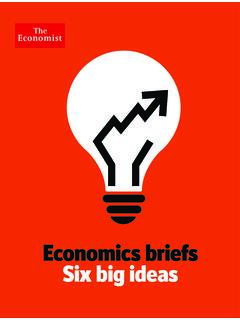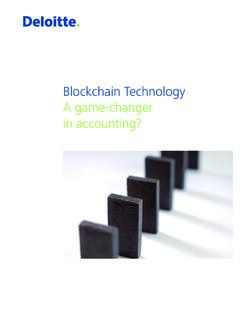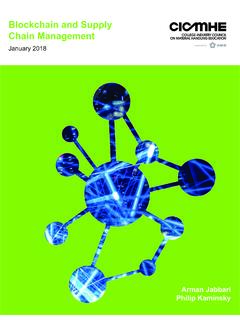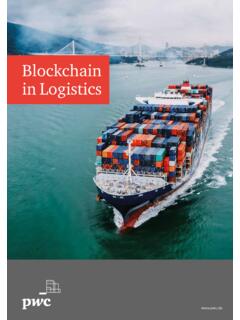Transcription of Digital Voting with the use of Blockchain Technology
1 Digital Voting with the use of Blockchain Technology Team Plymouth Pioneers Plymouth University Andrew Barnes, Christopher Brake and Thomas Perry Word count: 2992 2 Contents 1. Summary .. 3 2. Introduction .. 3 3. What is a Blockchain and how is it Commonly Used? .. 4 4. Current Digital Voting Systems .. 6 5. Our Proposal .. 8 Registration .. 8 Voting Mechanism and Architecture .. 9 The Voting Process .. 11 6. Analysis of the Design .. 12 7. Conclusion .. 13 8. References .. 14 9. Appendix A Assumptions .. 15 10. Appendix B .. 16 3 1. Summary The aim of this report is to outline our proposal to solving the issues of Digital Voting by using Blockchain Technology . The report starts by introducing the problems with current Voting practices, it then goes into a brief explanation of what Blockchain Technology is and how it is currently used.
2 The following section looks at present day deployments of Digital Voting and the issues they face. The main section of the report is a detailed breakdown of our proposed design followed by an analysis of potential flaws and threats. The final section is a conclusion of how we feel our design solves the issue at hand. 2. Introduction Democratic Voting is a crucial and serious event in any country. The most common way in which a country votes is through a paper based system, but is it not time to bring Voting into the 21st century of modern Technology ? Digital Voting is the use of electronic devices, such as Voting machines or an internet browser, to cast votes. These are sometimes referred to as e- Voting when Voting using a machine in a polling station, and i- Voting when using a web browser.
3 Security of Digital Voting is always the biggest concern when considering to implement a Digital Voting system. With such monumental decisions at stake, there can be no doubt about the system s ability to secure data and defend against potential attacks. One way the security issues can be potentially solved is through the Technology of blockchains. Blockchain Technology originates from the underlying architectural design of the cryptocurrency bitcoin. It is a form of distributed database where records take the form of transactions, a block is a collection of these transactions. With the use of blockchains a secure and robust system for 4 Digital Voting can be devised. This report outlines our idea of how Blockchain Technology could be used to implement a secure Digital Voting system.
4 3. What is a Blockchain and how is it Commonly Used? Blockchain Technology was first used within Bitcoin and is a public ledger of all transactions. A Blockchain stores these transactions in a block, the block eventually becomes completed as more transactions are carried out. Once complete it is then added in a linear, chronological order to the Blockchain . The initial block in a Blockchain is known as the Genesis block or Block 0 . The genesis block is usually hardcoded into the software; it is special in that it doesn t contain a reference to a previous block. ( Genesis Block , 2015) Once the genesis block has been initialised Block 1 is created and when complete is attached to the genesis block. Each block has a transaction data part, copies of each transaction are hashed, and then the hashes are paired and hashed again, this continues until a single hash remains; also known as a merkle root (Figure 1).
5 The block header is where the merkle root is stored. To ensure that a transaction cannot be modified each block also keeps a record of the previous blocks header, this means to change data you would have to Figure 1: Hash table 5 modify the block that records the transaction as well as all following blocks, as seen in Figure 2. ( , 2009) A Blockchain is designed to be accessed across a peer-to-peer network, each node/peer then communicates with other nodes for block and transaction exchange. Once connected to the network, peers start sending messages about other peers on the network, this creates a decentralised method of peer discovery. The purpose of the nodes within the network is to validate unconfirmed transactions and recently mined blocks, before a new node can start to do this it first has to carry out an initial block download.
6 The initial block download makes the new node download and validate all blocks from block 1 to the most current Blockchain , once this is done the node is considered synchronised. Figure 2: Simplified Bitcoin Block Chain (Source: , 2009) 6 4. Current Digital Voting Systems A number of Digital Voting systems are currently in use in countries around the world. We researched some of these systems to familiarise ourselves with current implementations, particularly Estonia. Estonia has had electronic Voting since 2005 and in 2007 was the first country in the world to allow online Voting . In the 2015 parliamentary election of all votes were made though the nation s i- Voting system (Vabariigi Valimiskomisjon, 2016). The bases of this system is the national ID card that all Estonian citizens are given.
7 These cards contain encrypted files that identify the owner and allows the owner to carry out a number of online and electronic activities including online banking services, digitally signing documents, access their information on government databases and i- Voting . (Electronic ID Card, no date) In order to vote, the voter must enter their card into a card reader and then access the Voting website on the connected computer. They then enter their PIN number and a check is made to see if they are eligible to vote. Once confirmed, they are able to cast/change their vote up until four days before election day. The voter may also use a mobile phone to identify themselves for i- Voting if they do not have a card reader for their computer. However, this process requires a specialised SIM card for the phone.
8 (Estonian Ministry of Foreign Affairs, 2015) When a voter submits their vote, the vote is passed though the publicly accessible vote forwarding server to the vote storage sever where it is encrypted and stored until the online Voting period is over. Then the vote has all identifying information cleaned from it and is transferred by DVD to a vote counting server which is disconnected from all networks. This 7 server decrypts and counts the votes and then outputs the results. Each stage of this process is logged and audited. During the 2013 Local Election, researchers observed and studied the i- Voting process and highlighted a number of potential security risks with the system. One such risk is the possibility of malware on the client side machine that monitors the user placing their vote and then later changing their vote to a different candidate.
9 Another possible risk is for an attacker to directly infect the servers though malware being placed on the DVDs used to set up the servers and transfer the votes. (Springall et al., 2014) However, this report has also come under criticism from the Estonian Information Systems Authority. (Veldre, 2014) Figure 3: Estonian Digital Voting System (Source: R. Verbij. "Dutch e- Voting opportunities." Master thesis, University of Twente, 2014) 8 5. Our Proposal For our design we tried to create a system that doesn t entirely replace the current Voting but rather integrates within a current system. We decided to do this to allow for as many different ways to vote as possible, this is so Voting can be accessed by the majority of the population.
10 Registration The first aspect of our design is the registration process, verifying a voter is essential in establishing security within the system. Making sure that someone s identity isn t being misused for fraudulent purposes is important, especially when Voting is considered, where every vote matters. A design of our registration process can be found in Appendix B Figure 4. To allow users to register to vote our proposed service utilizes both postal based forms as well as web forms requiring the same information to ensure we cater for those without a direct internet connection. This information includes their national identity number (an example would be a UK citizen s national insurance number), postal address, optional email address and a password.














